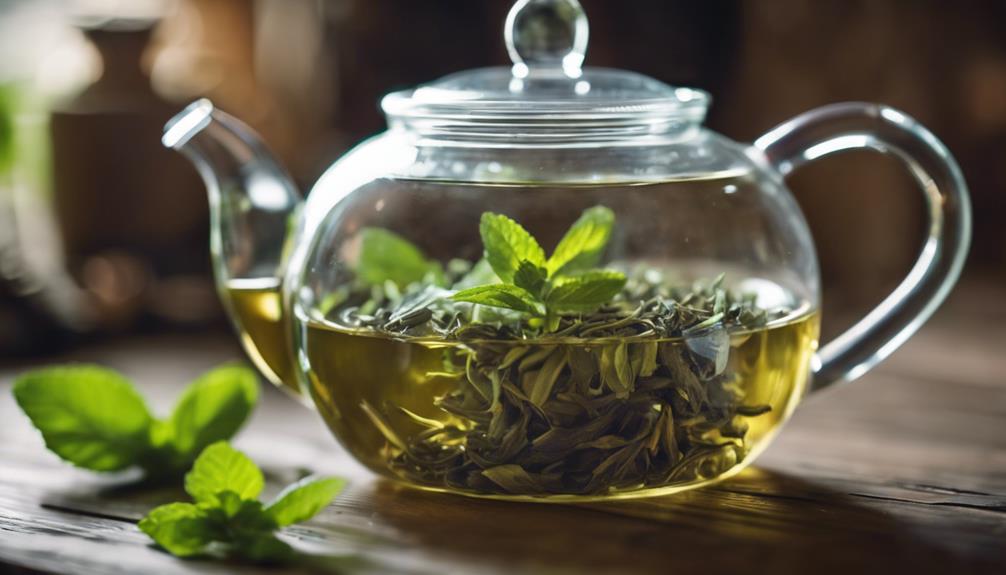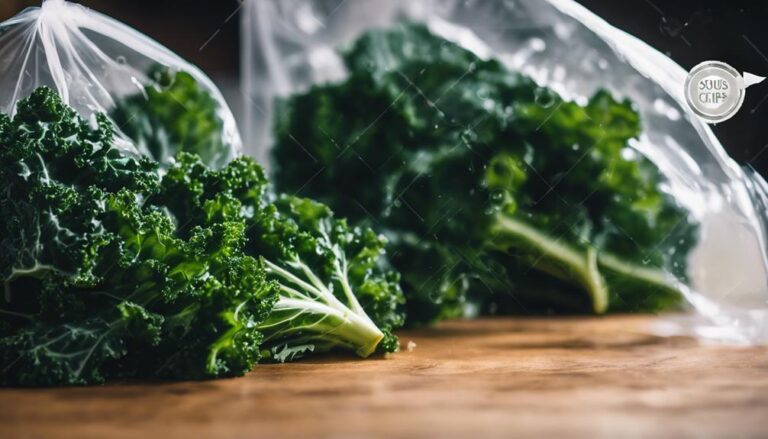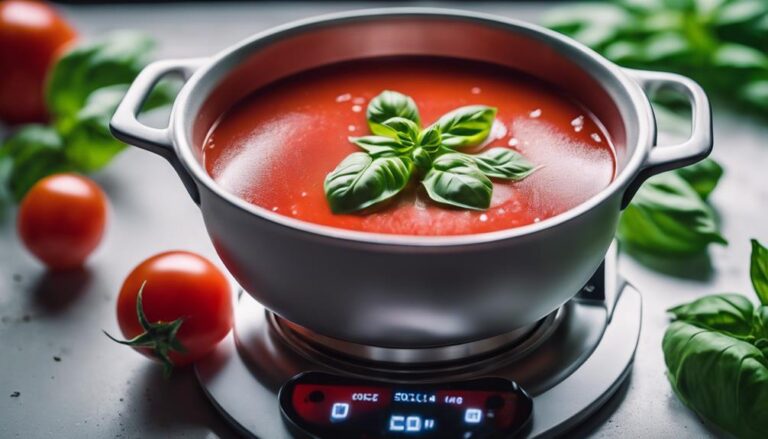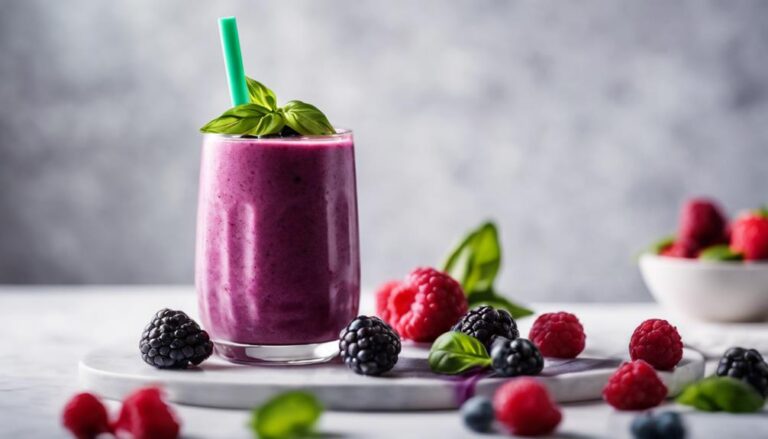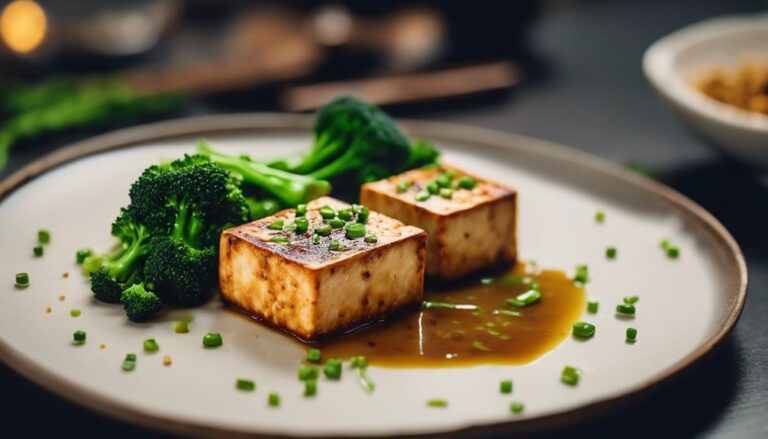Sous Vide Green Tea With Mint
Enhance your green tea with mint using sous vide for a invigorating blend. Fill a bag with green tea leaves, mint, and water. Seal and sous vide at 175°F for 45 minutes. This method guarantees a delicate infusion of flavors. Once done, add sweetener if desired. The controlled temperature extracts maximum taste without bitterness. The result? A perfect balance of earthy green tea and fresh mint. Take your tea experience to a new level with this innovative technique.
What You Will Learn Here
- Sous vide green tea enhances flavor extraction.
- Mint infusion adds refreshing aroma and taste.
- Precise temperature control for optimal results.
- Sous vide method preserves delicate green tea properties.
- Experiment with infusion times for desired strength.
Green Tea Origins in Asia
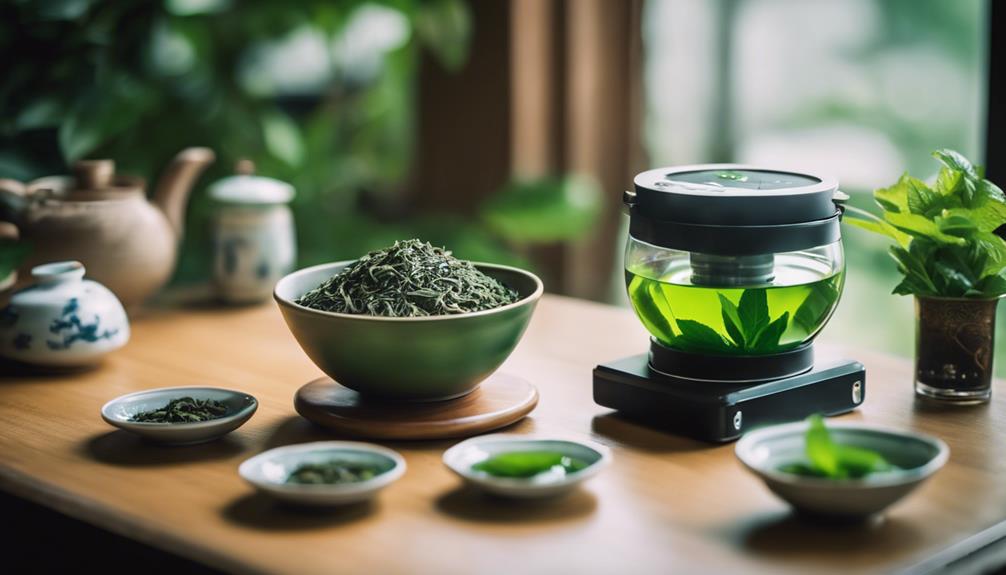
Green tea has its roots in ancient Asian tea traditions, with countries like China and Japan playing significant roles in its history.
The health benefits of green tea, such as antioxidants and potential weight management properties, have made it a popular choice worldwide.
Alongside its health benefits, green tea is deeply intertwined with cultural rituals in various Asian societies.
Asian Tea Traditions
Originating in Asia, green tea has been a central element in many traditional tea ceremonies and cultural practices across the continent. In Asian countries like Japan and China, the tea ceremony holds significant importance, emphasizing harmony, respect, and tranquility. The brewing techniques differ from region to region, with each method aiming to bring out the best flavors from the tea leaves.
In Japan, the tea ceremony, known as 'chanoyu' or 'sado,' involves precise rituals that have been practiced for centuries. The preparation of matcha, a powdered green tea, is a key component of this ceremony, requiring careful attention to detail in whisking the tea to create a frothy texture. On the other hand, in China, the Gongfu Cha ceremony focuses on using small teapots and multiple short infusions to extract the full range of flavors from the tea leaves.
These traditional practices not only showcase the cultural significance of green tea but also highlight the artistry and mindfulness that go into brewing and enjoying this beloved beverage in Asian communities.
Tea's Health Benefits
Amidst its rich history in Asian tea traditions, green tea boasts a myriad of health benefits that have been celebrated for centuries. Green tea is renowned for its high levels of tea antioxidants, such as catechins and epigallocatechin gallate (EGCG), which are known for their potent health-promoting properties. These antioxidants help combat oxidative stress in the body, reducing the risk of chronic diseases and inflammation.
One of the key health benefits of green tea is its positive impact on metabolism. Studies suggest that the catechins in green tea can help increase fat oxidation and improve insulin sensitivity, leading to enhanced weight management and a reduced risk of obesity-related conditions. Incorporating green tea into your daily routine may support a healthy metabolism and aid in achieving your wellness goals.
In addition to its antioxidant and metabolism-boosting properties, green tea is also a great source of hydration and contains beneficial nutrients like vitamins and minerals. By enjoying a cup of green tea regularly, you can't only savor its invigorating taste but also reap the numerous health benefits it has to offer.
Cultural Tea Rituals
In the heart of Asian tea culture, tea ceremonies steeped in tradition and symbolism have long been an integral part of daily life. Japanese tea ceremonies, known as 'chanoyu' or 'sado,' emphasize harmony, respect, purity, and tranquility. These rituals involve meticulous preparation and serving of matcha, a powdered green tea. The host performs precise movements with grace and intention, creating a serene atmosphere for guests to enjoy the tea.
Chinese tea rituals, on the other hand, vary across different regions and can involve various types of teas such as oolong, black, or pu-erh. The Gongfu tea ceremony, popular in southern China, focuses on the art of brewing tea with skill and precision. It involves multiple short steepings of tea leaves in small teapots, allowing for a full sensory experience of the tea's aroma, flavor, and texture.
Both Japanese and Chinese tea rituals highlight the significance of mindfulness, connection, and appreciation for the intricate flavors of green tea, fostering a sense of harmony and balance in daily life.
Key Ingredients for Infusion
When making green tea with mint, the key ingredients for infusion are essential to achieve the perfect balance of flavors. Here are some essential components you'll need:
- Green Tea Leaves: The base of your infusion, green tea leaves provide a delicate and grassy flavor profile that pairs beautifully with the fresh mint.
- Fresh Mint Leaves: Adding an invigorating and aromatic element, fresh mint leaves complement the green tea with their cooling and slightly sweet notes.
- Filtered Water: The quality of water used in the infusion process can greatly impact the overall taste. Opt for filtered water to guarantee a clean and pure flavor.
- Honey or Sugar: To sweeten your green tea with mint to your liking, having honey or sugar on hand is important. Adjust the sweetness level to suit your taste preferences.
Matcha Latte Twist
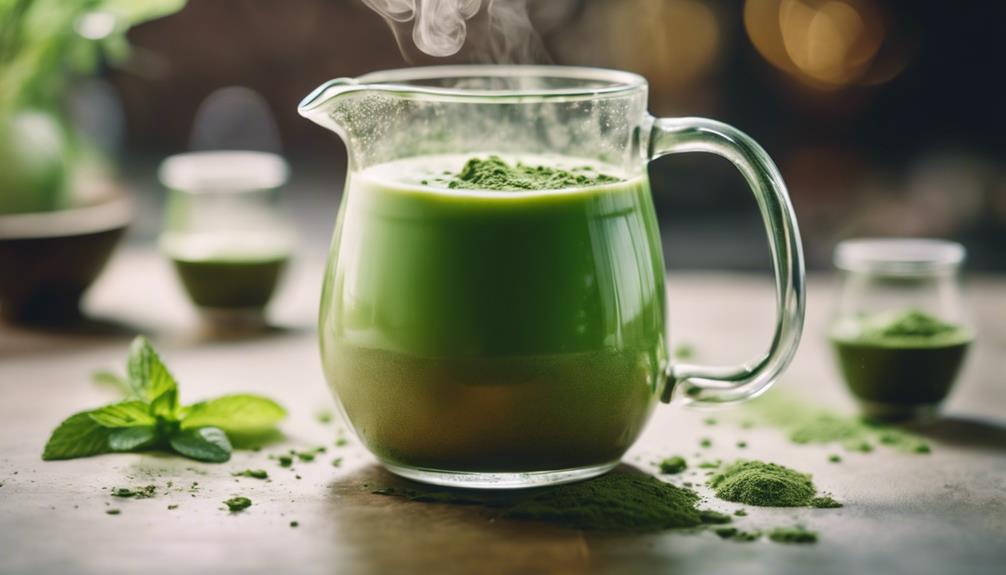
Let's talk about the invigorating Matcha Latte Twist.
This subtopic covers the Minty Matcha Latte Recipe, the Minty Matcha Smoothie Recipe, and the Minty Matcha Popsicles Recipe.
Get ready to explore these revitalizing and minty matcha creations that will surely elevate your green tea experience.
Minty Matcha Latte Recipe
For an exhilarating twist on your traditional matcha latte, consider incorporating revitalizing mint into the mix. Minty matcha lattes offer an invigorating take on this beloved drink, perfect for a rejuvenating start to your day or a mid-afternoon pick-me-up.
Here are some tips to elevate your matcha latte with a hint of mint:
- Fresh Mint Leaves: Add a few fresh mint leaves to your matcha latte for a burst of aromatic flavor.
- Mint Infused Syrup: Prepare a mint-infused syrup by simmering mint leaves with sugar and water, then mix it into your matcha latte for a sweet and minty kick.
- Mint Extract: A drop of mint extract can intensify the mint flavor in your latte without altering the drink's texture.
- Mint Garnish: Sprinkle finely chopped mint leaves on top of your matcha latte for a visually appealing presentation and an extra pop of minty freshness.
Experiment with these minty additions to create a delightful twist on your classic matcha latte. Enjoy the fusion of earthy matcha and invigorating mint for a truly unique beverage experience.
Minty Matcha Smoothie Recipe
To continue your exploration of mint-infused delights, immerse yourself in an invigorating twist with the Minty Matcha Smoothie Recipe, offering a delightful variation on the classic matcha latte experience. Whether you're seeking a rejuvenating green tea blend or exploring minty matcha desserts, this smoothie recipe is sure to tantalize your taste buds.
Here are some key points to ponder:
- Matcha Magic: The use of high-quality matcha powder guarantees a vibrant green hue and a rich, earthy flavor profile.
- Minty Freshness: Fresh mint leaves introduce a burst of coolness and a pleasant herbal note to the smoothie.
- Creamy Goodness: Creamy coconut milk or Greek yogurt can be integrated for a luxurious texture and added creaminess.
- Sweet Symphony: Balancing the flavors with a touch of honey or maple syrup brings a harmonious sweetness to this invigorating beverage.
Indulge in this Minty Matcha Smoothie for a revitalizing treat that combines the goodness of green tea with the invigorating essence of mint.
Minty Matcha Popsicles Recipe
Craving an invigorating and indulgent treat on a warm day? Try making these Minty Matcha Popsicles for a flavorful popsicle that will surely rejuvenate you. Here's how to whip up this delicious Matcha Latte Twist recipe:
- Start by mixing coconut milk, honey, and matcha powder in a bowl until smooth.
- Pour the mixture into popsicle molds, filling them halfway.
- Add a layer of fresh mint leaves for a burst of vitality.
- Top off the molds with the remaining matcha mixture and insert popsicle sticks.
Place the molds in the freezer for a few hours until the popsicles are completely frozen. Once ready, run the molds under warm water for a few seconds to easily remove the popsicles. These Minty Matcha Popsicles are a delightful and invigorating treat that combines the earthy taste of matcha with the cooling sensation of mint. Enjoy this unique twist on a classic popsicle for a cool and satisfying dessert.
Brewing Green Tea Effectively
To brew green tea effectively, remember the importance of water temperature, the variations in steeping time, and the influence of tea quality.
Start by heating water to the perfect temperature according to the type of green tea you're brewing, then steep the tea for the recommended time for best flavor extraction.
Water Temperature Importance
Achieving the ideal water temperature is essential for brewing green tea effectively and extracting its full flavor potential. Temperature control plays a vital role in bringing out the delicate nuances of green tea.
Green tea leaves are sensitive and require a gentle touch to reveal their complex flavors. Water that's too hot can scorch the leaves, resulting in a bitter brew, while water that's too cold may not extract the full range of flavors.
To strike the right balance, aim for a water temperature around 175°F to 185°F (80°C to 85°C) when brewing green tea. This range allows the tea leaves to unfurl gradually and release their flavors without becoming overly bitter.
The proper water temperature ensures that the delicate compounds in green tea, such as antioxidants and amino acids, are extracted optimally, enhancing both the taste and health benefits of the tea.
Paying attention to water temperature is a simple yet essential step in brewing a perfect cup of green tea.
Steeping Time Variations
For ideal flavor extraction and a well-balanced brew, varying the steeping time is key when brewing green tea effectively. Different steeping techniques can greatly influence the flavor profiles of your green tea. Shorter steeping times tend to result in a lighter taste with subtle notes, while longer steeping times can enhance the flavor, sometimes leading to bitterness.
Infusion experimentation allows you to explore the vast array of flavors that green tea has to offer. By adjusting the steeping time, you can reveal different aroma profiles in your tea. Shorter steeping times might bring out floral or grassy notes, whereas longer steeping times can amplify the umami or vegetal aspects of the tea.
To truly appreciate the complexity of green tea, don't be afraid to experiment with steeping times. Keep a record of your experiments to find the perfect balance that suits your taste preferences. Enjoy the journey of aroma exploration through the simple act of adjusting your steeping time.
Tea Quality Influence
Quality tea leaves greatly impact the overall taste and brewing experience when making green tea effectively. Tea grading, which categorizes tea based on quality, plays a significant role in determining the flavor profile of your brew. Higher-grade tea leaves tend to offer more nuanced and complex flavors, resulting in a more satisfying cup of green tea.
When choosing tea for brewing, opt for high-quality loose-leaf varieties over tea bags, as they generally contain better-grade leaves that are less processed and retain more of their natural flavors. Additionally, consider experimenting with different brewing methods to bring out the best in your tea.
For example, using lower water temperatures and shorter steeping times can help prevent the bitterness that sometimes accompanies green tea brewing. By paying attention to tea quality and exploring various brewing techniques, you can enhance your green tea experience and savor the delicate flavors and aromas that high-quality tea leaves have to offer.
Final Thoughts

As you conclude your experience with green tea infused with mint, consider the revitalizing blend's ability to invigorate both your senses and your well-being. Reflections on the flavor profile may reveal a delicate balance between the grassy notes of green tea and the invigorating essence of mint. The subtle sweetness of mint harmonizes with the earthy undertones of green tea, creating a soothing and aromatic infusion that lingers on your palate.
Whether enjoyed hot or cold, this fusion of green tea and mint offers a moment of tranquility in a busy day. The cooling effect of mint complements the gentle warmth of green tea, providing a sensory journey that can transport you to a state of relaxation. The combination of flavors not only delights your taste buds but also leaves you feeling refreshed and rejuvenated.
In the hustle and bustle of daily life, taking a moment to savor a cup of green tea with mint can be a simple yet luxurious act of self-care. So, as you sip on this revitalizing blend, let its calming properties and delightful taste remind you to pause, breathe, and indulge in a moment of tranquility.
Frequently Asked Questions
Can I Use Any Type of Green Tea for Sous Vide Infusion?
Yes, you can use various types of green tea for sous vide infusion. Different tea varieties offer unique flavors, while herbal combinations enhance complexity. Experiment with infusion techniques to maximize flavor extraction and create delightful tea blends.
What Are Some Alternative Herbs to Mint for Flavoring?
If you're looking for alternatives to mint for flavoring, consider lemon basil or rosemary. These herbs can provide a unique twist to your dishes and beverages, adding a fresh and aromatic touch to your creations.
How Long Can I Store Sous Vide Green Tea?
When storing sous vide green tea, consider shelf life and storage conditions. To maintain freshness, follow best practices for preservation. Keep in mind that proper storage can help prolong the tea's quality and flavor.
Can I Reuse the Infused Green Tea Leaves?
You can reuse the infused green tea leaves for tea leaves composting or in various herbal tea recipes. It's a sustainable way to get extra flavor and benefits from your tea leaves while reducing waste.
Are There Any Health Benefits Specific to Sous Vide Green Tea?
Sous vide offers benefits like precise cooking and enhanced flavors. Green tea infusion through sous vide can provide an antioxidant boost, revealing health perks unique to this method. Enjoy the rich taste and potential wellness advantages.
Conclusion
To sum up, sous vide green tea with mint offers a unique and flavorful twist on a traditional beverage. By infusing green tea with fresh mint leaves, you can create a rejuvenating and aromatic drink that's both calming and invigorating.
Experiment with different brewing methods and ingredients to find your perfect cup of green tea. Whether enjoyed hot or cold, this infusion is sure to delight your taste buds and provide a moment of relaxation in your day.
Cheers to a delicious and rejuvenating tea experience!
